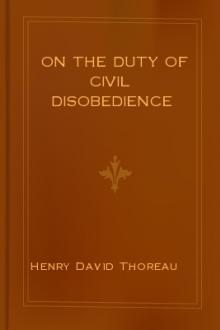Essays Henry David Thoreau (little bear else holmelund minarik .txt) 📖

- Author: Henry David Thoreau
Book online «Essays Henry David Thoreau (little bear else holmelund minarik .txt) 📖». Author Henry David Thoreau
After breakfast we proceeded to the fall, which was within half a mile, and at this distance its rustling sound, like the wind among the leaves, filled all the air. We were disappointed to find that we were in some measure shut out from the west side of the fall by the private grounds and fences of Patterson, who appropriates not only a part of the water for his mill, but a still larger part of the prospect, so that we were obliged to trespass. This gentleman’s mansion-house and grounds were formerly occupied by the Duke of Kent, father to Queen Victoria. It appeared to me in bad taste for an individual, though he were the father of Queen Victoria, to obtrude himself with his land titles, or at least his fences, on so remarkable a natural phenomenon, which should, in every sense, belong to mankind. Some falls should even be kept sacred from the intrusion of mills and factories, as water privileges in another than the millwright’s sense. This small river falls perpendicularly nearly two hundred and fifty feet at one pitch. The St. Lawrence falls only one hundred and sixty-four feet at Niagara. It is a very simple and noble fall, and leaves nothing to be desired; but the most that I could say of it would only have the force of one other testimony to assure the reader that it is there. We looked directly down on it from the point of a projecting rock, and saw far below us, on a low promontory, the grass kept fresh and green by the perpetual drizzle, looking like moss. The rock is a kind of slate, in the crevices of which grew ferns and goldenrods. The prevailing trees on the shores were spruce and arbor-vitæ—the latter very large and now full of fruit—also aspens, alders, and the mountain-ash with its berries. Every emigrant who arrives in this country by way of the St. Lawrence, as he opens a point of the Isle of Orleans, sees the Montmorenci tumbling into the Great River thus magnificently in a vast white sheet, making its contribution with emphasis. Roberval’s pilot, Jean Alphonse, saw this fall thus, and described it, in 1542. It is a splendid introduction to the scenery of Quebec. Instead of an artificial fountain in its square, Quebec has this magnificent natural waterfall to adorn one side of its harbor. Within the mouth of the chasm below, which can be entered only at ebb tide, we had a grand view at once of Quebec and of the fall. Kalm says that the noise of the fall is sometimes heard at Quebec, about eight miles distant, and is a sign of a northeast wind. The side of this chasm, of soft and crumbling slate too steep to climb, was among the memorable features of the scene. In the winter of 1829 the frozen spray of the fall, descending on the ice of the St. Lawrence, made a hill one hundred and twenty-six feet high. It is an annual phenomenon which some think may help explain the formation of glaciers.
In the vicinity of the fall we began to notice what looked like our red-fruited thorn bushes, grown to the size of ordinary apple-trees, very common, and full of large red or yellow fruit, which the inhabitants called pommettes, but I did not learn that they were put to any use.
III St. AnneBy the middle of the forenoon, though it was a rainy day, we were once more on our way down the north bank of the St. Lawrence, in a northeasterly direction, toward the Falls of St. Anne, which are about thirty miles from Quebec. The settled, more level, and fertile portion of Canada East may be described rudely as a triangle, with its apex slanting toward the northeast, about one hundred miles wide at its base, and from two to three, or even four hundred miles long, if you reckon its narrow northeastern extremity; it being the immediate valley of the St. Lawrence and its tributaries, rising by a single or by successive terraces toward the mountains on either hand. Though the words Canada East on the map stretch over many rivers and lakes and unexplored wildernesses, the actual Canada, which might be the colored





Comments (0)